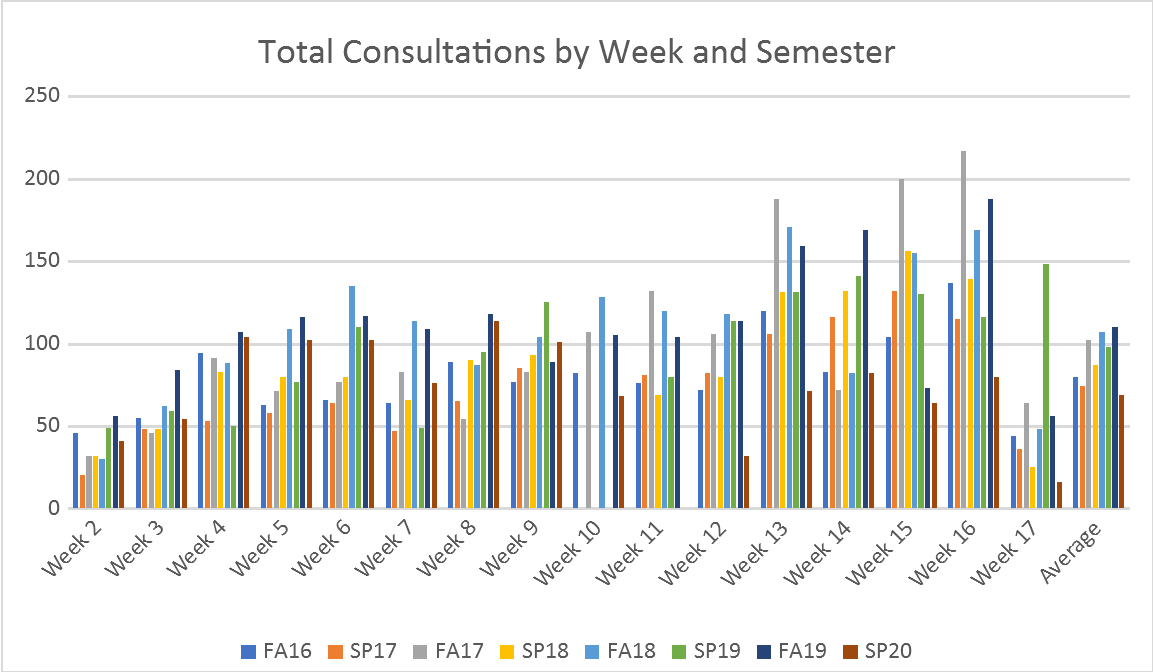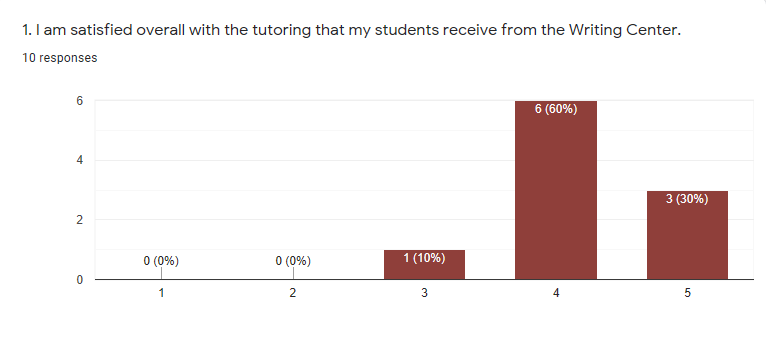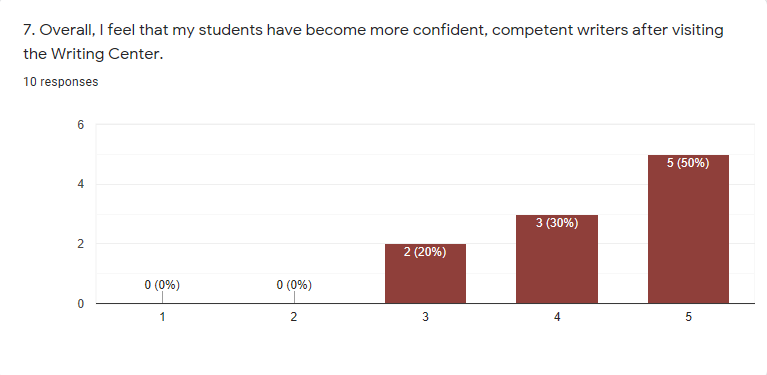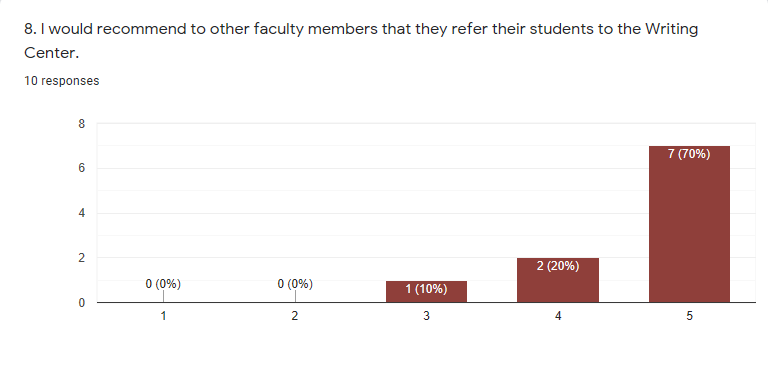Writing Center
Annual Report 2019–2020
Table of Contents
- Introduction
- Goals and Accomplishments
- Report progress on goals identified in last year’s report
- 2. Summarize department and faculty highlights. (Provide a brief account of this year’s significant happenings and department accomplishments. Include faculty recognitions, honors, publications, presentations, etc.)
- 3. Complete the table below for faculty (excluding part-time instructors) as of May 2020, then provide part-time instructor information below the table.
- Department Effectiveness
- 10. Please add any other performance data you might like to include here that will help inform an accurate snapshot of your department.
- 11. Conduct SWOT Analysis—Strengths, Weaknesses, Opportunities, Threats (Identify internal strengths and weaknesses, and external opportunities and threats. Analysis of facilities, resources, administration/staff, budgets, outside influences, competition and stakeholder satisfaction.)
- Chair’s Response—Planning for the Future
- 12. Based on the above data, list specific goals your department/unit will target to accomplish during the coming academic year. Note: In next year’s report, follow up reporting on these goals will be covered in #1 as in this report.
- 15. What are department’s projected needs for the next 3–5 years? Include staffing, space, budget, etc.)
- Dean’s Response
- 17. Provide your overall response to the degree of success this department achieved last year relative to student learning outcomes. Consult with Assessment Coordinators to review the action plan and insights they have entered in TaskStream—they can print out a report for you.
- 18. Provide your general assessment of the accomplishments and needs, including budget allocation needs (particularly address # 14 & #15).
- Summary of Meeting with Provost
2020 Annual Review
Introduction
Department Name: Writing Center
College Name: Library & Learning Services
Department Head: Rob Gray
Department Mission Statement (required for NWCCU):
The mission of the Dixie State University Writing Center is to assist students in developing, drafting, and revising their writing through peer-to-peer consultation and small group instruction. We strive to create an academic community of strong and confident writers, both at Dixie State University and in the southern Utah community.
Goals and Accomplishments
1. Report progress on goals identified in last year’s report.
LLS Goal 2: Expand Resources and Enhance Services
Strategy: Increase total consultations this academic year
- We feel we accomplished our desired outcome of a 10-percent increase. Our total consultations for 2019–2020 were 3,137, down slightly from 3,194 visits the previous year; however, we were on track for 3,800 appointments before the transition to remote learning. This would have put us at a 19 percent increase over 2018–2019. We accomplished this goal through two strategies:
- We hired a marketing intern to increase awareness of the Writing Center. Some of her marketing strategies are below:
- Dixie Announce faculty and staff emails
- Campus A-frame advertising
- Trailtracker Student newsletter
- Email to parents
- Faculty information flyers
- Canvas announcements
- Social media campaign
- Campus TV monitor ads
- Blazer Digest ads
- We held an open house the first week of fall semester and invited all faculty and staff to attend. Although we had fewer than 100 attendees, those who did attend got a first-hand look at our learning centers and our strategies for success.
- We hired a marketing intern to increase awareness of the Writing Center. Some of her marketing strategies are below:
Strategy: Increase departmental tutoring
- We completed our desired outcome of adding two departmental tutors for students writing ACS style and those studying exercise science.
LLS Goal 3: Contribute to Campus-Wide Retention Efforts
Strategy: Create a study to show that mandatory Writing Center tutoring in English 1010 and 1010D is effective in aiding students writing proficiency.
- We attained our desired outcome of correlating Writing Center visits with student essay score and final grade improvement.
- Students who took their essays to the Writing Center for help received an average essay grade of 2.94 (roughly a B) compared to an average grade of 1.60 (C-) for those who did not.
- Students who took their essays to the Writing Center for help received an average course grade of 3.25 (roughly a B+) compared to 2.18 (C+) for those who did not.
LLS Goal 4: Remove Barriers to Access and Improve Efficiencies
Strategy: Increase department efficiency
- We attained our desired outcome of making the Writing Center more efficient by adjusting our tutoring hours. We lowered our number of tutors at certain times of the day and increased numbers at other times to better match student demand.
- We created an ongoing training program for tutors to brush-up on their skills. We will implement these Canvas modules next fall.
2. Summarize department and faculty highlights. (Provide a brief account of this year’s significant happenings and department accomplishments. Include faculty recognitions, honors, publications, presentations, etc.)
Director of Learning Services:
Rob Gray applied for and received CRLA program certification for the Academic Performance Center, the Writing Center, the Peer Coaching program, and the Supplemental Instruction program. He is heading a committee to pursue a Title III SIP grant for five-year funding for supplemental instruction, expanded tutoring, and first-year experience. He co-wrote an article on mandatory tutoring that was published in Curiosity, DSU’s online research journal.
Student coordinators:
Brittany Bennett was our Writing Center coordinator through the end of spring semester. She graduated with a degree in history and a minor in English. She wrote articles for the 2019 DSU Annual Academic Report.
Ashton Corsetti became our coordinator after spring semester. He is an English major with a Professional and Technical Writing emphasis. He worked as an editor of Curiosity, DSU’s online research journal, and had an article published in last year’s edition.
Student tutors:
Corbin Caldwell earned his TEFL (Teaching English as a Foreign Language) certificate from Bridge Academy.
Abby Doman worked as the managing editor of the Dixie Sun News.
Ryan Gibb attended a competitive biomedical internship at Stanford University last summer and graduated this year with a BS Degree in Biology with an English minor.
Abby Lewis acquired a tutoring position at Techie for Life, a local, neuro-diverse student-support company.
Haley Evans began DSU’s graduate program in Technical Writing and Digital Rhetoric.
Kaitlyn Ehlers graduated with a English degree and obtained employment with Washington County School District as a middle school teacher.
3. Complete the table below for faculty (excluding part-time instructors) as of May 2020, then provide part-time instructor information below the table.
| Name and Degree | Tenure Status T = Tenured TT = Tenure Track NTT = Non Tenure Track |
Rank | Faculty FTE | Released Time in Credit Hours |
|---|---|---|---|---|
| Rob Gray, MFA | NTT | Director | 1.0 | N/A |
Department Effectiveness
10. Please add any other performance data you might like to include here that will help inform an accurate snapshot of your department or unit.
Department Highlights:
A. During the fall 2019 semester, the Writing Center completed 1,764 consultations, a 13 percent increase in total consultations over the spring 2019 semester (graph provided below).

B. The Writing Center was able to add two more department-specific tutors for writing ACS style and those studying exercise science.
C. Between the 2018-2019 academic year and the 2019-2020 year, the number of specialized tutoring sessions that the Writing Center completed with APA students, primarily psychology, increased by 11 percent, from 399 specialized sessions to 443.
D. Between the 2018–2019 academic year and the 2019–2020 year, the number of synchronous online tutoring sessions that the Writing Center completed increased by 81 percent, from 344 online tutoring sessions to 622.
Additional Department Effectiveness Data:
A. Last year, we analyzed data from a mandatory tutoring study we conducted in the Writing Center. The Executive Summary is below.
Mandatory Tutoring: English 1010 Results, Spring 2019
In spring 2019, the Writing Center obtained essay scores and course grades from five instructors and 12 sections of English 1010(D) at the university for 111 new freshmen. Student who did not submit an essay were excluded. In eight sections, it was mandatory for students to attend the writing center for assistance on at least one essay; however, only 60% of new freshmen in these sections took their papers to the writing center. On the other hand, it is important for instructors to do this, because in the four sections without this mandate, none of the new freshmen sought help from the writing center on their papers.
Outcomes were quite different for new freshmen who utilize the writing center compared to those who did not take advantage of the services. The average grade on the essay for those who used the center was 2.94 compared to 1.60 for those who did not; roughly a B compared to failing grades, below a C- on average. The average grade in the course for those who used the center was 3.25 compared to 2.18 for other new freshmen who did not use the writing center.
New freshman who took their papers to the writing center had a higher ACT Composite Score (19) and high school GPA (3.33) than students not taking advantage of services (18 and 3.02). The index score (high school GPA X 10 + ACT Composite) was 48 and 52 respectively, higher for those following their instructor’s guidelines.
One could argue that the difference was due solely to their lack of preparation in high school. To counter this argument, the researchers used a binary logistic regression to predict grades on the essay and grades in the English courses. This was chosen because grades were bimodal; therefore the outcomes were changed to earning a B or higher and C or higher on the essay and for the course grade.
In order to control for differences in high school preparation, the researchers used covariates or control variables in the analyses. Results were similar using different covariates (high school GPA, ACT score or index score). Therefore, the ACT score was chosen because of the larger sample size with this data.
Table 1. Logistic Regression Results (n = 111) Essay Course Grade B or Higher C or Higher B or Higher C or Higher Variables B S. E. B S. E. B S. E. B S. E. ACT Score .132 .069 .110 .068 .165* .072 .071 .080 Utilizing the Center 1.849** .437 1,950** .457 1.898** .476 1.390* .594 Constant -3.633** 1.327 -2.544* 1.280 -3.306* 1.346 -.331 1.447 Correctly Classified 73.0% 68.5% 70.0% 80.0% Nagelkerke R Square .263 .264 .273 .107 *p < .05, **p < .01
When controlling for students’ ACT Composite scores, student compliance with taking their paper to the writing center was associated with earning a B or higher and earning a C or higher on their essay. The same was true for their course grade (all tests statistically significant). Therefore, new freshmen are making a wise choice to utilize tutoring services on campus. The instructor can encourage this by requiring use of the center as part of the course.
B. In an online survey administered to faculty on their perceptions of the Writing Center, we found that most faculty believe that the Writing Center is effective in helping their students become stronger writers. Between 80 and 90 percent of respondents agree or strongly agree that faculty are satisfied with the tutoring students receive, that faculty are confident in the advice tutors give, that their students are more confident writers after visiting with tutors, and that they would recommend Writing Center services to other faculty members.




11. Conduct SWOT Analysis—Strengths, Weaknesses, Opportunities, Threats (Identify internal strengths and weaknesses, and external opportunities and threats. Analysis of facilities, resources, administration/staff, budgets, outside influences, competition and stakeholder satisfaction.)
Strengths
- We have an excellent coordinator and excellent tutors
- Our reputation on campus is very good
- We tutor a variety of writing on campus including specialty tutors in…
- ESL
- Nursing
- Psychology
- Media Studies
- English
- Our dean allows us to try new ideas
- We have strong management software that creates reports that allow us to make decisions based on data
- We have a very modern, inviting work space
- Many divisions, departments, and programs are willing to collaborate with us
- We have adequate funding
- We have new computers (adequate technology)
- We have an excellent assessment plan
Weaknesses
- As we continue to expand, we will run out of space soon
- We rely on student fee funding instead of permanent institutional funding
- Part-time, student coordinator makes turn-over inevitable
- Some faculty and staff still have misconceptions about our services
Opportunities
- We have funding to expand departmental tutoring
- We have funding to pursue mandatory tutoring with the English Department
- We can create a stronger marketing plan to alleviate misconceptions
Threats
- Outsourced tutoring is always a threat
- Lack of permanent funding
Chair’s Response—Planning for the Future
12. Based on the above data, list specific goals your department/unit will target to accomplish during the coming academic year. Note: In next year’s report, follow up reporting on these goals will be covered in #1 as in this report.
LLS Goal 2: Expand Resources and Enhance Services
Strategy: Increase total consultations next academic year
- This goal is not being carried over from the previous year.
- Action Plan: Work with our intern to increase social media marketing and other forms including brochures and radio ads. Promote our services to faculty.
- Desired Outcome: Five percent increase in total appointments from last year.
- Timeline: One year
- No additional resources are needed.
Strategy: Increase tutoring of underserved populations
- This goal is not being carried over from the previous year.
- Action Plan: Work with the Multicultural Inclusion Center and the Structured Enrollment program to increase at-risk student visits.
- Desired Outcome: Increase minority and structured enrollment student visits by five percent over the previous year.
- Timeline: One year
- No additional resources are necessary.
LLS Goal 3: Contribute to Campus-wide Retention Efforts
Strategy: Show Writing Center Effectiveness
- This goal is not being carried over from a previous year.
- Action Plan: Survey students to discover their perception of tutor effectiveness.
- Desired Outcome: Eighty percent of students who attend Writing Center sessions agree that tutors are effective in making students more confident, independent writers.
- Timeline: One year
- No additional resources are necessary.
15. What are department’s projected needs for the next 3–5 years? Include staffing, space, budget, etc.)
The Writing Center’s biggest need in the next few years will be additional space. As our program continues to grow and as the Athletic Department will require additional tutoring to meet Division 1 standards, Learning Services will need additional room.
Another need will be additional funding, and we plan to address this with a Title III grant.
